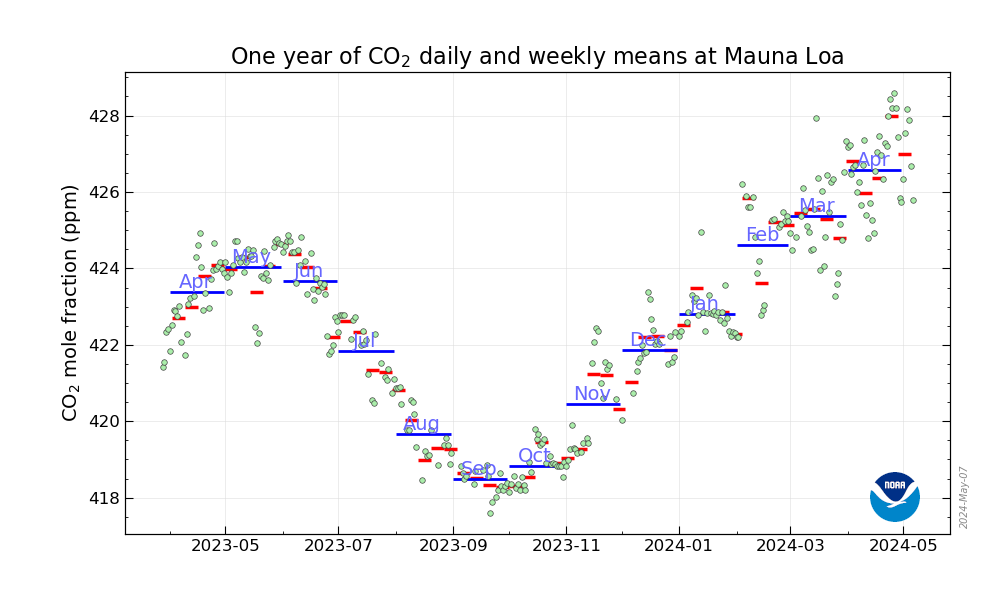One of the agencies that keeps track of and reports on carbon dioxide levels is NOAA (National Oceanic and Atmospheric Administration). Here is a link to their weekly CO2 report - Trends in Carbon Dioxide. For the week beginning May 5, 2013 the level is 399.5 which is up 2.5 ppm since last year at the same time and 21.65 ppm from ten years ago. It is important to note that May is usually the highest month for carbon dioxide levels so that generally means that this should be the highest it gets this year. These levels are mostly due to seasonal reasons - spring plants will soon "breathe" in a large portion that builds up over the winter when there is less plant matter. This photosynthesis and respiration within ecosystems changes the levels of the greenhouse gas CO2 and also the useful, breathable gas, oxygen as it is a product of photosynthesis. On May 13, 2013 there was a single day reading of 400.07 ppm from their facility in Mauna Loa, HI. As you can see from the graph below, the levels of CO2 rise and fall throughout the year.

Source: NOAA website: Earth System Research Laboratory (Global Monitoring Division)
The NOAA/Mauna Loa website states that they are located "on the north flank of Mauna Loa Volcano, on the Big Island of Hawaii and that due to its remote location in the Pacific Ocean, high altitude (3397 meters, or 11,135 feet above sea level), and great distance from major pollution sources, MLO is a prime spot for sampling the Earth's background air in the well mixed free troposphere." The website also states that, "The mission of ESRL is to measure atmospheric constituents that are capable of forcing change in the climate of the earth and those that may deplete the ozone layer. ESRL accomplishes this goal primarily through long-term tropospheric measurements of key atmospheric parameters such as carbon dioxide (CO2), carbon monoxide (CO), methane (CH4), chlorofluorocarbons (CFCs), ozone (O3), sulfur dioxide (SO2), nitrous oxide (N2O), radon, aerosols, optical depth, and a spectrum of solar radiation parameters."
Their location is such that sampling is done without as much active (locally centered) pollution adding to the overall mix. This is important so that the measurement is globally "correct" and not just for the United States or North America. There are sampling stations all over the globe to further support the numbers that are being measured at Mauna Loa Observatory.
What does this mean for us? It shows a consistent growth of overall CO2 in our atmosphere over the last number of decades and shows a trend. You will find arguments on all sides of the climate change argument that says this is too high, just right or too low. The reality is we try to figure out what has happened in the past to trigger major climate changes like ice ages because it would greatly affect the living things on the planet including us. What I believe it does show is that there is a consistent trend showing that CO2 levels are increasing over time. Is this anthropogenic (human-induced)? Yes and no. Some is nature and some is done by humans. Can we affect how all of nature is producing, using and storing CO2 - no. The only way to reduce greenhouse gas emissions is to control our own production, use and storage. It is widely known that there are many actions that humans do to produce large amounts of greenhouse gases. We can control our own behavior and it may behoove us to do so sooner than later. The problem with waiting is that there may very well be a tipping point where we adversely affect our environment to the point that it is detrimental to our well-being.





